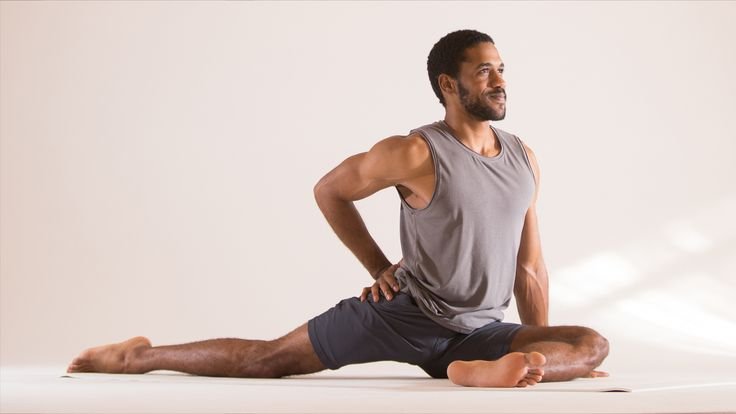
Introduction: What Is Functional Flexibility?
Functional flexibility refers to the range of motion and strength that supports everyday movements and fitness activities. Unlike static flexibility, which focuses solely on stretching, functional flexibility combines mobility, stability, and control, enabling the body to move efficiently and safely in various scenarios.
Yoga, with its dynamic poses and breathing techniques, serves as an ideal practice for developing functional flexibility. By integrating yoga into a fitness routine, individuals can enhance their performance in sports, prevent injuries, and improve overall mobility.
The Science Behind Functional Flexibility in Yoga
Yoga helps improve functional flexibility by targeting the fascia, muscles, and joints through intentional movement. Here’s how:
- Stretching the Fascia
The fascia, a connective tissue network surrounding muscles, can become tight and restrict movement. Yoga poses like Downward Dog or Triangle Pose create gentle tension, helping the fascia stay hydrated and elastic. - Building Strength Through Range of Motion
Dynamic yoga poses such as Warrior I and Chair Pose not only stretch muscles but also strengthen them in extended ranges, promoting better control during fitness activities. - Breath Control and Neuromuscular Connection
Breathing exercises (pranayama) improve oxygen delivery to muscles and calm the nervous system, allowing deeper stretches and more coordinated movement.
Yoga Poses That Enhance Functional Flexibility
- Cat-Cow Pose(Marjaryasana-Bitilasana)
- Improves spinal mobility and strengthens core stabilizers.
- Prepares the back and hips for functional movements like lifting and twisting.
- Low Lunge with Side Stretch(Anjaneyasana with Variation)
- Opens hip flexors while strengthening the thighs.
- Enhances the ability to perform squats and lunges with greater depth.
- Half Lord of the Fishes Pose(Ardha Matsyendrasana)
- Promotes spinal rotation and flexibility.
- Supports activities involving twisting motions, such as golf or tennis.
- Pigeon Pose(Eka Pada Rajakapotasana)
- Targets deep hip rotators and glutes.
- Reduces stiffness from prolonged sitting or high-impact activities.
- Bridge Pose(Setu Bandhasana)
- Engages the glutes and stretches the hip flexors.
- Strengthens the posterior chain for functional movements like running or jumping.
The Role of Yoga in Injury Prevention
Functional flexibility isn’t just about enhancing performance—it’s a vital component of injury prevention. Yoga helps in:
- Correcting Muscle Imbalances
Repeated movements in fitness routines, such as weightlifting or running, can lead to imbalances in muscle groups. Yoga’s holistic approach ensures equal attention to all major muscles, promoting balance. - Improving Proprioception
Proprioception refers to the body’s awareness of its position in space. Balance-focused yoga poses like Tree Pose improve proprioception, reducing the likelihood of sprains and falls. - Strengthening Ligaments and Tendons
Gentle, sustained stretching in yoga strengthens connective tissues, making them more resilient to sudden stress or strain.
Integrating Yoga with Fitness Training
Combining yoga with traditional fitness routines amplifies the benefits of both. Here’s how:
- Yoga as a Warm-Up
Dynamic flows like Sun Salutations prepare muscles for high-intensity workouts by increasing blood flow and improving mobility. - Yoga as Active Recovery
Post-workout yoga sessions, focusing on gentle stretches and breathing, accelerate recovery by flushing out lactic acid and reducing muscle soreness. - Yoga for Core Strength
Poses like Plank and Boat Pose strengthen the core, which is essential for stability and power in exercises such as deadlifts or burpees.
The Mental Benefits of Functional Flexibility Through Yoga
Yoga isn’t just a physical practice—it also nurtures the mind. Functional flexibility gained through yoga brings:
- Improved Focus and Coordination
The mindfulness cultivated in yoga enhances mental clarity, allowing better coordination during complex fitness movements. - Reduced Stress
Breath-focused practices activate the parasympathetic nervous system, reducing cortisol levels and creating a state of relaxation. - Increased Confidence
Achieving greater control over one’s body boosts confidence, whether on the yoga mat, in the gym, or during daily activities.
Case Studies: Real-Life Applications of Functional Flexibility
- For Athletes
Professional athletes often integrate yoga into their training to improve agility and recover faster from injuries. For instance, basketball players benefit from yoga’s ability to enhance hip flexibility and jumping mechanics. - For Desk Workers
Yoga alleviates stiffness caused by long hours of sitting. Poses like Cat-Cow and Forward Fold release tension in the back and neck, making daily tasks more comfortable. - For Seniors
Yoga improves joint health and balance, reducing the risk of falls and enabling seniors to maintain independence in their movements.
Future of Functional Flexibility in Yoga and Fitness
As fitness trends evolve, functional flexibility will remain a cornerstone of effective training. Emerging practices like yoga therapy and fascia-focused flows highlight the growing recognition of yoga’s role in long-term health and fitness.
Technology is also playing a role, with yoga apps and wearable devices offering tailored routines to enhance flexibility and track progress. This integration of ancient practice with modern tools ensures yoga’s continued relevance in the fitness world.
Conclusion
Functional flexibility bridges the gap between traditional yoga and modern fitness, offering a holistic approach to movement and health. By incorporating yoga into their routines, individuals can unlock their body’s full potential, improve performance, and protect themselves from injuries—all while nurturing mental well-being.
Whether you’re an athlete, a fitness enthusiast, or someone seeking better mobility in daily life, yoga is the key to sustainable, functional flexibility.




